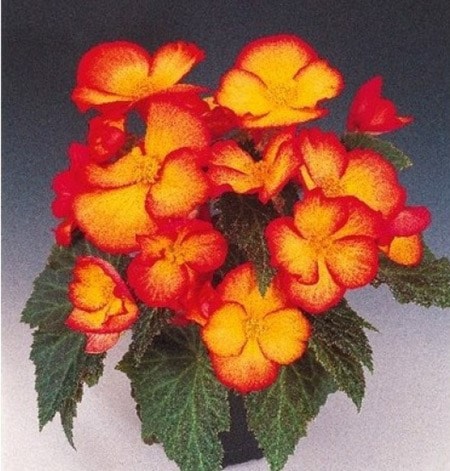For shady garden areas, tuberous begonias are one of the old-time favourites. Today, the ‘non-stops’, which can be started from seed or tuber with equal success, are the most popular by far. Their blossom size is not quite up to par with the older tuber camellia-flowered varieties, but their colour range and incredible garden performance is amazing. ‘Non-stops’ will also tolerate a fair amount of sunshine, allowing you to use them in many more areas. There are many new varieties and some have almost black foliage. Two relatively new seedling strains are the very large and spectacular Pin-Up Series ‘Flame’, a yellow and orange bicolour and ‘Rose‘, a stunning white with deep rose edgings.
As for tubers, I’m excited about the ‘Maxima’ series of begonias. They are very similar to ‘non-stops’, but they also have single female flowers which can be left on for a most pleasing effect. Europeans tend to prefer these more prolific varieties with smaller blossoms and longer blooming periods. They are also more weather tolerant.
‘Crispa Marginata’ begonias are singles but very much like multi-flowered varieties. They are the most prolific of all begonias, and they look quite similar to fibrous begonias. They tolerate sun as well as shade, but their real charm lies in their delightful, often black-coloured foliage, which, when contrasted with their intensely coloured flowers, creates a truly knockout effect.
If you are a fan of giant flowers, try some ‘California’ varieties. There are many flower forms on the market such as ruffled and camellia, as well as upright and trailing varieties. The starting tubers can be up to four inches across. One of the original breeders in California has renewed my faith in these magnificent old giants. It is not unusual to grow, even in the first year, flowers four to five inches in diameter. You many find them a little more expensive than other varieties, but you’ll see why once you see the results.
For the greatest success, use a peat and sand mixture to start all your begonia tubers. Try a ratio of three-quarters peat to one-quarter sand. Your might want to add a little floured bonemeal to this mix as well. Place your tubers in the smallest pot possible, (one just large enough to fit the tuber) being careful not to bury them too deeply. Water the tubers in thoroughly, and cover your pots with a clean dry cleaning bag to keep them humid and warm (18-21°C or 65-70°F). Then, place your pots on top of the refrigerator to keep them warm and make them sweat. If the tubers are sound, I guarantee you success every time using this method. To enjoy some early blossoms, now’s a good time to get your tubers started. And please, give some of the old tuber varieties a try this year. They are very unique and will create quite a stir in your garden.
If you just don’t have time to start tubers, don’t worry. Started plants will be in good supply in all stores by late April. Since begonias love warm temperatures, wait until May before setting them outside.
